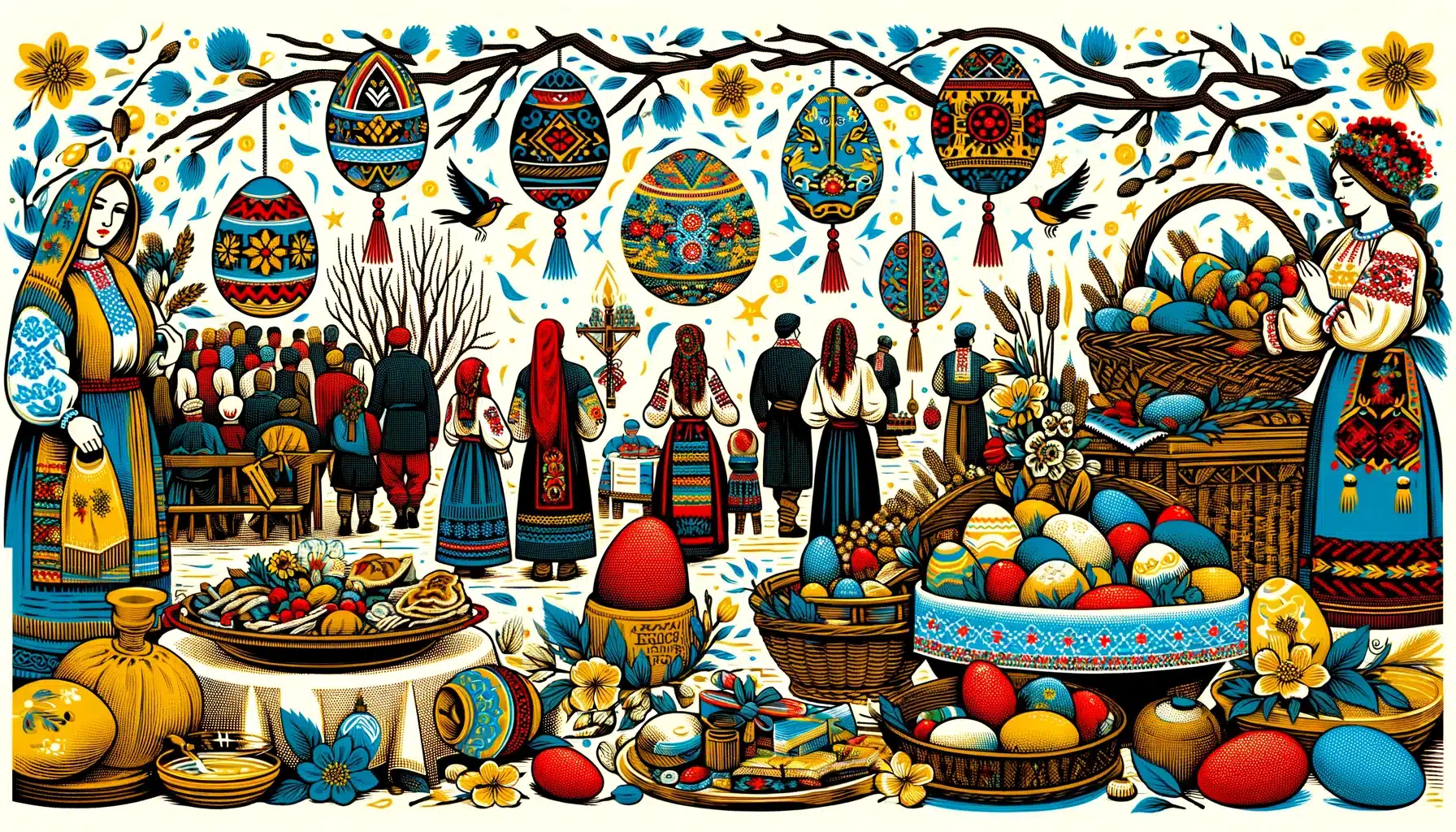
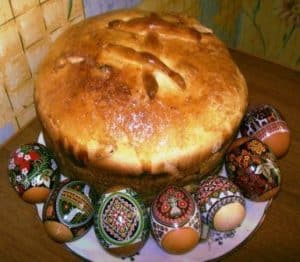
Dive into the heart of Slavic cultural traditions with a whimsical whirl through the vibrant Easter traditions of Russia and Ukraine, where the ancient customs and folk art burst into a kaleidoscope of colors, flavors, and profound symbolism. Welcome to a tale of Paskha (Пасха), the pinnacle of Orthodox Christian celebrations, blending sacred mysteries and secular fun into a spectacular springtime symphony.
In this enchanting corner of the world, where Russian folk traditions and Ukrainian cultural heritage intertwine, Easter isn’t just a holiday; it’s an epic extravaganza of faith, festivity, and folk tradition. With the majority embracing the Eastern Orthodox faith in Russia’s heart and Ukraine’s eastern realms, and Catholicism painting the west of Ukraine with its own hues, you’re in for double the delight. Thanks to a historical twist of the calendar, Easter parties here come in twos—each painted with the unique brushstrokes of Slavic Easter customs and celebrations in Ukrainian culture.
Take a leap into the Eastern Orthodox Easter with a midnight spectacle, the Paschal Vigil, a cornerstone of Orthodox Christian celebrations and Russian folk traditions. This tradition, dripping with folkloric art and symbolism, features priests and congregants parading around the church, symbolizing a march towards the resurrected Savior—a vibrant embodiment of Slavic cultural traditions. The moment when the procession halts before closed doors and then bursts into a chorus of “Christ is Risen!” is a scene straight out of the most jubilant of traditional Slavic festivals.
Flip the scene to the Catholic Church’s observance, where the Easter Triduum introduces a narrative steeped in Ukrainian cultural heritage. Picture a church, shrouded in darkness, suddenly alight with the promise of renewal, a symbol as potent as any in Eastern European folk motifs. This rite, a profound display of festivities in Russian culture, leads believers through a night of reflection, ultimately culminating in the joyous declaration, “Truly He is risen,” a phrase echoing through the ages in celebrations in Ukrainian culture.
- More about the Eastern tradition, including the history, from the Ukrainian Encyclopedia
- Easter service at St. Elias Monastery
- Thy Resurrection, O Christ Our Saviour : A Russian Orthodox Christian Pascha (Easter) Chant
- Easter Procession
Pysanki (Писанки)
But oh, the Easter eggs, or Pisanki (Писанки), are not just eggs; they’re a canvas for expressing the rich tapestry of Slavic and Eastern European cultural traditions. From geometric patterns to storytelling scenes, these eggs are a riot of color and creativity, each a masterpiece of folkloric art and symbolism, resonating with the depth of Russian traditions and Ukrainian cultural heritage. The tradition of creating pysanki involves a delicate wax-resist method, allowing artists to imbue each egg with intricate patterns and vibrant hues, making them not just decorations but talismans of health, fertility, and protection. Every year, families gather to partake in this time-honored craft, passing down techniques and motifs that have adorned their celebrations for generations.
Faberge Eggs
 And who could forget the Fabergé saga? A tale of opulence, tradition, and the historical importance of Easter in Russian culture, these treasures are a testament to the lavish side of Russian folk traditions, marrying the celebratory spirit of Easter with the unparalleled artistry of Russian folk art—a highlight of the cultural heritage of Eastern Europe. The allure of Fabergé eggs goes beyond their stunning exteriors, as each creation hides a unique story or surprise, making them a cherished symbol of the mysteries and joys of life. Today, collectors and museums around the world vie for the privilege of housing these remarkable pieces of Russian heritage, a testament to their enduring appeal and the master craftsmanship of Peter Carl Fabergé and his artisans.
And who could forget the Fabergé saga? A tale of opulence, tradition, and the historical importance of Easter in Russian culture, these treasures are a testament to the lavish side of Russian folk traditions, marrying the celebratory spirit of Easter with the unparalleled artistry of Russian folk art—a highlight of the cultural heritage of Eastern Europe. The allure of Fabergé eggs goes beyond their stunning exteriors, as each creation hides a unique story or surprise, making them a cherished symbol of the mysteries and joys of life. Today, collectors and museums around the world vie for the privilege of housing these remarkable pieces of Russian heritage, a testament to their enduring appeal and the master craftsmanship of Peter Carl Fabergé and his artisans.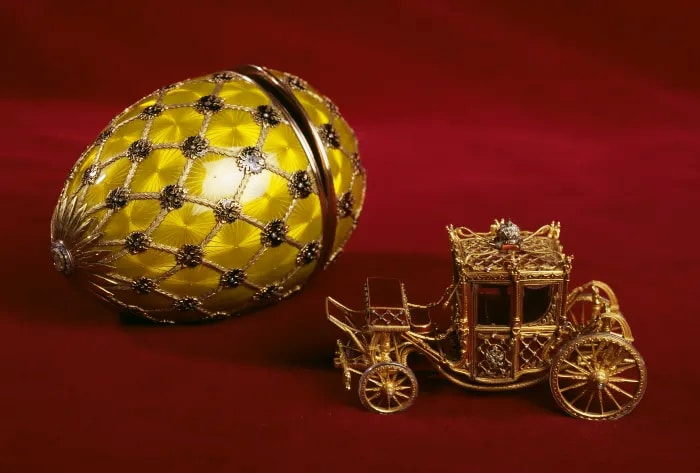
Traditional Easter Paska
Feasting also plays a starring role, with traditional foods like paska and kulich not just feeding the body but nourishing the soul with their deep symbolic meanings, a culinary reflection of the traditions and celebrations steeped in Russian and Ukrainian cultural heritage. Paska, with its rich, brioche-like texture, often bears religious symbols on its crust, serving as a centerpiece that bridges the sacred with the celebratory. Kulich, meanwhile, is enjoyed with a smear of sweet, creamy cheese frosting, often carrying the letters XB, for “Christ is Risen,” crowning it as a festive declaration of faith and joy. These dishes, surrounded by a variety of other delectable treats, turn the Easter table into a lavish spread that delights the senses and uplifts the spirit, showcasing the best of Slavic culinary arts in celebration of renewal and life.
So there you have it, a peek into the Easter extravaganza, where tradition, art, and faith dance in a dazzling display of Slavic spirit. Whether you’re in it for the spiritual journey or here for the eggs and cakes, the Easter traditions of Russia and Ukraine are a feast for the soul, the senses, and the sweet tooth, embodying the spirit of Slavic cultural traditions and the rich.
Kulich recipe (Yield 2 kuliches (8 inches tall and 4 inches in diameter)
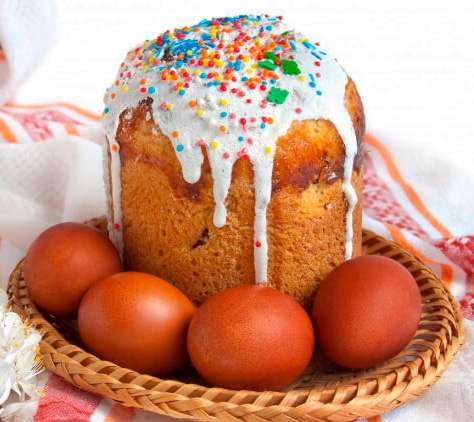
Ingredients:
¾ cup milk, warmed to room temperature
1 ounce fresh yeast or 0.4 to 1/2 ounce active dry yeast
3½ cups flour, separated
½ cup sugar, separated
4 to 5 egg yolks
2 tablespoons cognac
Dash of vanilla extract
3 1/2 ounces melted butter
½ teaspoon lemon zest
1⁄4 teaspoon nutmeg
1⁄4 teaspoon cardamom
4 ounces raisins
Pinch of salt
For glaze:
1/5 cup sugar
2 to 3 tablespoons water or milk
½ teaspoon lemon juice
Or
1 cup powdered sugar
2 tablespoons milk
½ teaspoon vanilla extract
About 2 tablespoons sprinkles, for decoration
Preparation:
- Prepare yeast starter: to the warm milk, add yeast, 1⁄3 of the flour, and 1 tablespoon of the sugar and mix thoroughly until well integrated. Set aside for 20 minutes in a warm place.
- Whisk yolks with remaining sugar for several minutes, until they become white. Add cognac, vanilla extract and melted butter and mix until well integrated.
- Mix the yolk mixture into the yeast starter and stir well. Add zest, nutmeg, cardamom and the remaining flour. The add the remaining flour gradually, stirring all the while to ensure the dough remains soft and light.
- Knead the dough for at least 10 minutes, then put in a large bowl, cover with a towel and leave to rise in a warm place for an hour, until the volume doubles.
- Lightly grease the inside of the form or container you’re using with vegetable oil, put the dough into the forms, filling them up halfway, and set aside for half an hour. Preheat the oven to 350°F.
- Bake the kuliches for 35 minutes, then lower the heat of the oven to 300°F and bake for another 25 minutes. Check the readiness by piercing the kulich with a toothpick – the toothpick should emerge dry.
- Meanwhile prepare the glaze: In a saucepan over medium heat, cook sugar with water or milk for several minutes, stirring constantly to make a smooth, pourable glaze. Add lemon juice, stir once more and remove from heat.
- Remove kuliches from the oven, pour the glaze over the top and sprinkle. Set kuliches aside to cool.
Cottage Cheese Paska recipe 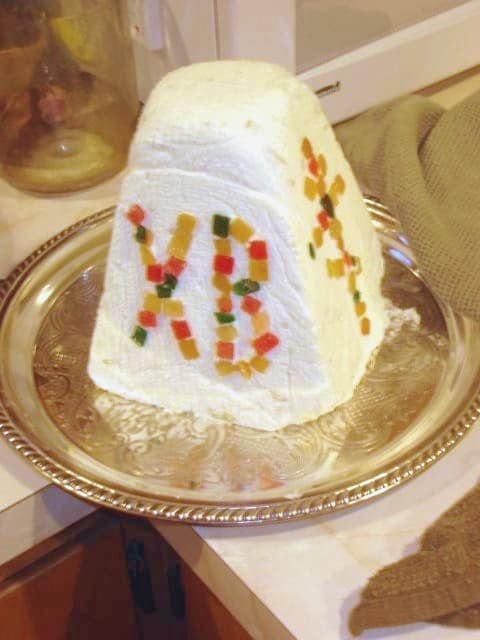
Ingredients:
½ cup raisins
1 pound high fat cottage cheese
2 eggs
7 ounces sour cream
1⁄4 cup sugar, or to taste
1 teaspoon vanilla extract
3 1/2 ounces butter (room temperature), cut into small pieces
3 ounces candied fruit, any kind
2 ounces chopped nuts, any kind, optional
Special Equipment:
A wooden or plastic paska cheese mold called pasochnitsa
Double layered cheesecloth
2 pound weight or something equally heavy (a jar of something, a pitcher of water, etc)
Preparation:
- Rinse raisins, pour boiling water over them and leave for 20 minutes. Drain the water and dry the raisins on a paper towel.
- If using store bought cottage cheese, rub cottage cheese through a sieve twice or blend it in a blender to make it creamy and uniform.
Note: if you made the cottage cheese yourself and it is soft and smooth, you can skip this step.
- Add eggs, sour cream, sugar and vanilla extract to the cottage cheese and mix well.
- Add butter and use a mixer to whip the mass until fluffy and homogeneous.
- Pour the mass into a thick-walled saucepan. Cook it on low heat for several minutes, stirring constantly, until it begins to bubble. Turn the heat off immediately. Do not allow the mixture to boil.
- Lower the saucepan into a bowl with cold water (preferably with ice cubes) and stir until completely cooled. Set aside some candied fruit and nuts for decoration, then add raisins, remaining fruit and nuts to the chilled mass and mix well.
- Cool the mass for 1 to 2 hours in the refrigerator to thicken.
- Line the mold or whatever container you’re using with dampened cheesecloth and put the mass inside. Fold the cheesecloth over the top of the mass, covering it. Cover with a lid or small plate and place weight on top. Put on another plate to catch any runoff and put in refrigerator for 24 to 30 hours.
- Remove paska from container, unwrap the cheesecloth, and put paska onto a serving plate.
Decorate with candied fruit and nuts, if desired.

